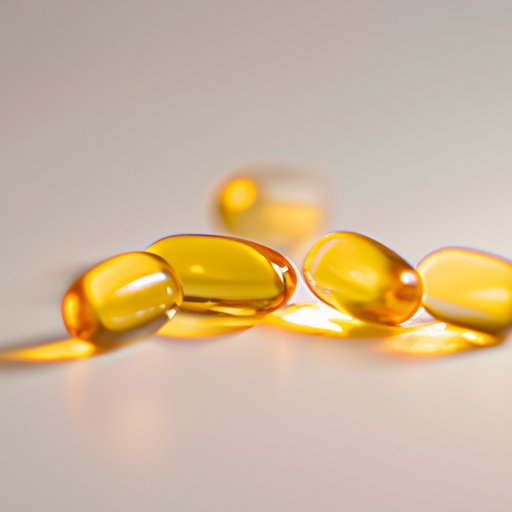
Introduction
Have you ever wondered what vitamin is in the sun? The answer is Vitamin D, also known as the sunshine vitamin. This essential nutrient plays a vital role in our overall health and well-being. In this article, we’ll explore all there is to know about this crucial vitamin, how it is produced in the body and the importance of safe sun exposure in maintaining optimal levels.
Vitamin D is required for several functions in the body, from maintaining healthy bones to regulating the immune system. Unfortunately, studies have shown that many people are deficient in this vital nutrient. In fact, nearly 42% of American adults are Vitamin D deficient, which can result in a range of health problems. But don’t worry, with a little bit of knowledge and effort, we can all maintain healthy levels of Vitamin D.
What You Need to Know About Vitamin D: The Sunshine Vitamin
Vitamin D is a fat-soluble vitamin that is essential for the body to function properly. It can be obtained through exposure to sunlight, certain foods, and supplements. The reason it is called the “sunshine vitamin” is that the body can produce it when the skin is exposed to sunlight.
Vitamin D plays an important role in bone health by helping the body maintain calcium levels and promoting bone growth. It also modulates cell growth, supports the immune system, and reduces inflammation. In addition, research has linked sufficient levels of Vitamin D to a lower risk of developing certain cancers, cardiovascular disease, and multiple sclerosis, among other health benefits.
The Connection Between Sun Exposure and Vitamin Production
When the skin is exposed to the sun, it triggers a chemical reaction that produces Vitamin D. More specifically, UVB rays from the sun interact with a type of cholesterol in our skin, which then helps in the conversion of Vitamin D3. Once it is produced, it travels to the liver, where it is converted to its active form.
Although we can obtain Vitamin D from food and supplements, the most natural and efficient way to get it is through sun exposure. The amount of time it takes to produce enough Vitamin D varies depending on a multitude of factors, including skin color, geographic location, and the time of year. However, it typically takes between 10-30 minutes of exposure to the sun’s UVB rays on uncovered skin to produce enough Vitamin D.
Unraveling the Mystery of Sunlight and Vitamin D Synthesis
The process of Vitamin D synthesis from sunlight involves several chemical reactions that transform Vitamin D2 and D3 to its active hormonal form, calcitriol. This active form of Vitamin D then works in several ways throughout the body, including the essential function of regulating calcium in the blood and, thus, promoting bone mineralization.
However, certain factors can impact the rates at which the body produces this crucial nutrient. For example, darker skin colors and the use of sunscreen can inhibit Vitamin D synthesis. Furthermore, where you live can impact your ability to get Vitamin D from sun exposure. People living in areas further from the equator, like the Northern United States, often have difficulty getting enough sunlight exposure during the winter months to produce sufficient Vitamin D. Such factors highlight the importance of a balanced approach to achieving optimal Vitamin D levels.
Why Spending Time Outdoors is Crucial for Getting Enough Vitamin D
Spending time outdoors is not only a great way to maintain good health overall, but it is also an easy way to get enough Vitamin D from natural sunlight. As a result, people who typically stay indoors or live in northern climates should make an effort to get outside more often. There are many ways to do this, including going for a walk or jog, gardening, hiking, or just enjoying a sunny day at the beach.
When it comes to safe sun exposure, moderation is key. Too much unprotected sun exposure can be dangerous and increase the risk of skin cancer. Experts recommend wearing protective clothing, hats, and sunglasses, and using sunscreen with a minimum of SPF 30 to ensure safe sun exposure. Moreover, those who have a history of skin cancer or have certain medical conditions should consult a doctor before making any changes to sun exposure and should always take precautions to remain safe.
Nature’s Vitamin D: How Sunlight Helps Your Body Produce Essential Nutrients
Although Vitamin D can be obtained in supplemental form, food sources are limited, and it can be challenging to achieve adequate levels through diet alone. However, when our bodies produce Vitamin D from the sun, it’s in its most natural active form, making it easier for our bodies to absorb and utilize.
Moreover, getting Vitamin D from sunlight not only supports healthy bones but also has been linked to reduced risk of various health complications. By spending time outdoors, we can obtain this essential nutrient naturally, keep our bodies healthy, and prevent long-term health complications.
Conclusion
Vitamin D is an essential nutrient that all humans need for optimal health and well-being. Since it can be challenging to get enough Vitamin D from food sources and supplements alone, spending time outdoors and getting natural sunlight exposure is crucial. By practicing safe sun exposure, understanding the natural synthesis process, and getting outside more, we can all achieve optimal levels of Vitamin D.
In conclusion, experiencing the outdoors and spending some time in the sun has numerous health benefits that go beyond just Vitamin D production. The key is to be mindful, take precautions, and enjoy all that nature has to offer.





